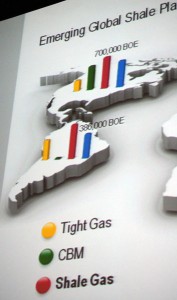Drilling Conference plenary: Frontier challenges depend on perspective
 Our industry is characterized by its frontier aspects. Yet today there are non-obvious aspects to what are deemed frontier areas, and these aspects are different for different players in our industry. The challenges of exploring and exploiting oil and gas in frontier areas were addressed during the plenary session on 2 March at the 2011 SPE/IADC Drilling Conference in Amsterdam.
Our industry is characterized by its frontier aspects. Yet today there are non-obvious aspects to what are deemed frontier areas, and these aspects are different for different players in our industry. The challenges of exploring and exploiting oil and gas in frontier areas were addressed during the plenary session on 2 March at the 2011 SPE/IADC Drilling Conference in Amsterdam.
Panelists were Mike Dyson, general manager of well engineering for BG Group; Peter Fontana, chief operating officer for Weatherford International; Kevin Robert, senior vice president of marketing and business development for Pride International; and Johan Surewaard, vice president of wells, new ventures, MENA, Russia, Caspian for Shell International E&P.
Mr Dyson began the discussion by presenting six “new” challenges that represent frontiers for our industry – new countries, new environments, new expectations, new technology, new people and new politics. Working in new countries involves having to establish government relations, partnering with other operators, managing logistics and supply, complying with HSE requirements, finding sufficient service company capabilities and having to hire and develop local staff, along with the potential for remote working through an integrated collaborative environment. According to Mr Dyson, piracy can also be an issue for offshore rigs, and mitigating those risks may involve working with the military.
“There’s also the uncertainty that the firm is setting up in a country when you don’t know whether the exploration venture is going to be a success. Drilling different types of wells can also require different types of technologies, different ways of working,” Mr Dyson said. Another challenge, new expectations, involves increased scrutiny from both inside and outside of the organization, particularly in a post-Macondo world. He believes this will affect partnering arrangements between operators and service companies. “There’s a lot to digest and act on as an industry,” Mr Dyson said.
Mr Fontana offered a different perspective, presenting challenges faced by the service and drilling sectors. He pointed to unconventional reserves as being frontier areas and further noted that often no infrastructure exists in these frontier areas. “Lots of things have to happen in order to get the product to market and to cut well costs. In the unconventional shale play, the challenge for the service sector is about understanding what and where to frac, and from what point to produce,” Mr Fontana said. Service intensity of completing these multistage fracs is also higher. “We also need to put in early production facilities and then move to more permanent facilities,” he said.
Mr Surewaard built on the two previous perspectives, pointing out that the issue around people is that it is difficult to get the right people for frontier ventures. “You have to rely on local people. Also, if you are the first one into a country, don’t expect that there are a lot of service companies there when you need them,” he said. It is difficult to predict when the task of setting up and beginning operations in a country will be completed. “It takes awhile to get there,” he said.
“It is important to bring people in early into these projects because, at the end of the day, it may be up to those people on the ground,” Mr Surewaard said. It is also important to remember that performance may be tailored to risk in frontier areas, so one should be careful to rate performance on work done safely and correctly. There should be different performance drivers in different categories of projects. “It’s not one size fits all,” he said.
Mr Robert brought the business aspects of frontier areas into the discussion. “There’s a lot of tradition in this area in our business,” Mr Robert said. Three ways to quantify business drivers in frontier areas are bifurcation (changes in qualitative structure resulting in changes in behavior), sovereign wealth funds (state-owned investment funds created by oil wealth) and commodity prices (oil and gas prices that impact E&P spending and activity).
“Some of our thought processes in our business right now are undergoing massive change,” Mr Robert said. “We see some bifurcation by asset quality and dayrates. What’s driving that is recent demand for higher-specification, multifunctional drilling rigs and increasing demands on personnel performance. It’s a new frontier for us to define competency from experience that’s not there. Capability is a bigger selection factor than the price of a drilling rig.”




